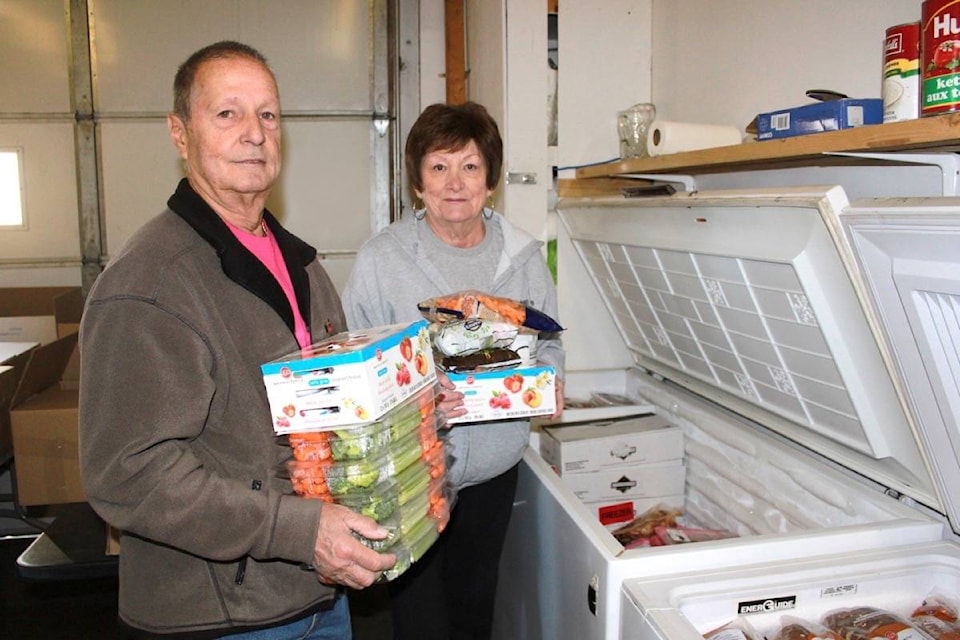100 Mile House Food Bank executive director Bob Hicks says the facility has returned to its regular hours following some busy weeks during the wildfire season.
The Food Bank is open the first and third Tuesdays of the month from 10 a.m. to 2 p.m. Volunteers take a lunch break from noon to 12:30 p.m.
Hicks says the Food Bank was very busy during the wildfire season, as it fed just under 6,000 people.
Between Jan.1 and July 7 this year, the Food Bank volunteers handed out around 1,300 hampers, he notes.
Following the evacuations – July 23 to Sept. 18 – Hicks says they doubled their first six month’s distribution numbers and handed out 2,600 hampers.
He adds there were no issues getting that many hampers out the door because “we had a lot of support and everything came together nicely.”
The Food Bank received help from several local volunteers and seven members of a Kamloops Rotary Club who spent a full day distributing hampers, Hicks says.
“The Islamic Relief Fund, based in Alberta, sent us a trailer load of food.
“An elderly couple in Stettler, Alta. took their trailer to their church, parked it there for a week and when it was loaded, they drove it to 100 Mile to donate it to our Food Bank. It was very nice of them.”
Hicks notes the Food Bank and SaveOn-Foods are working together on a new project called the Perishable Food Recovery Program.
“It stops food from going to the landfill, and in the last month-and-a-half, we have received 3,877 pounds of food that would normally go to the landfill from Save-On-Foods.
“There is a much bigger need at the food bank in this community than people realize,” says Richard Bullen, Save-On-Foods store manager. “Save-On-Foods is very happy to be able to support the Perishable Food Recovery Program which Bob and his volunteers initiated.”
Hicks says the local store provides meat, dairy and produce.
“It’s stuff that is getting close to its expiry date, but there’s absolutely nothing wrong with it.
“So they give it to the Food Bank and, in turn, we give it to our recipients.”
We also provide food to 100 Mile House Elementary School for its breakfast program, he says.
“We also help the Canadian Mental Health Association-South Cariboo Branch and the homeless people.”
Hicks says volunteers pick the excess produce up from Save-On-Foods every day and make it available on distribution days from 10 to noon on a first-come-first-serve basis.
The executive director notes if they get produce that doesn’t look too appealing, they will give it to people who will use it to feed their animals – chickens and pigs.
Hicks says they started the program just before the wildfire evacuation and got it rolling again in August.
Hicks notes the Food Bank can now issue a Farmers Tax Credit slip to producers who donate to the Food Bank.
“We never used to be able to do that, but in the last year, we set that program up. It works not too bad at all.”
He says Foodbanks BC provided a grant to the local Food Bank to purchase 10 new freezers. The new freezers will give them 15 in total, which, Hicks adds, will allow them to store more food.
As for the current status of the Food Bank, Hicks says they’re a “little low but not doing too bad.
“We’re going to make it; there’s no doubt about that.”
However, he adds, the Food Bank will be relying on all kinds of donations, such as the food they got from a Church of Latter-day Saints in Alberta recently.
The executive director says they will never close the doors to the Food Bank and they’ll always keep there distribution hours.
“We always find ways to get food.”
In conclusion, Hicks thanks the “community for everything they’ve done over the fire season.”
He notes the Food Bank didn’t just help 100 Mile House during the wildfires.
“We sent groceries out to Anahim Lake. We looked after Clinton, Cache Creek, Lone Butte and 70 Mile House … we looked after all areas. Anybody who needed help we were there to help them.”
